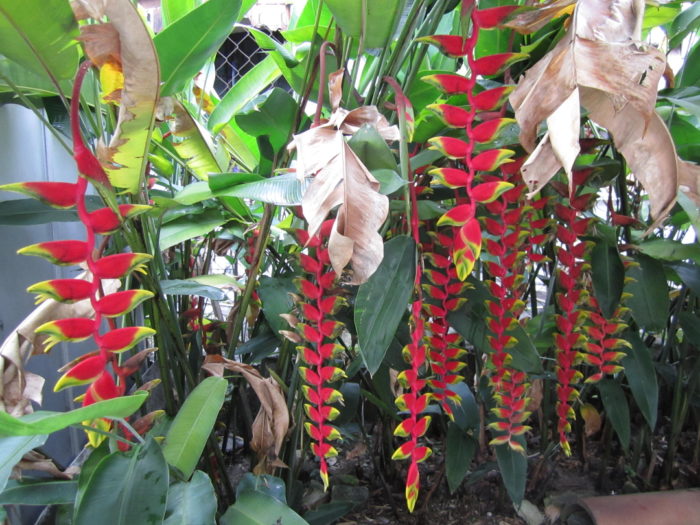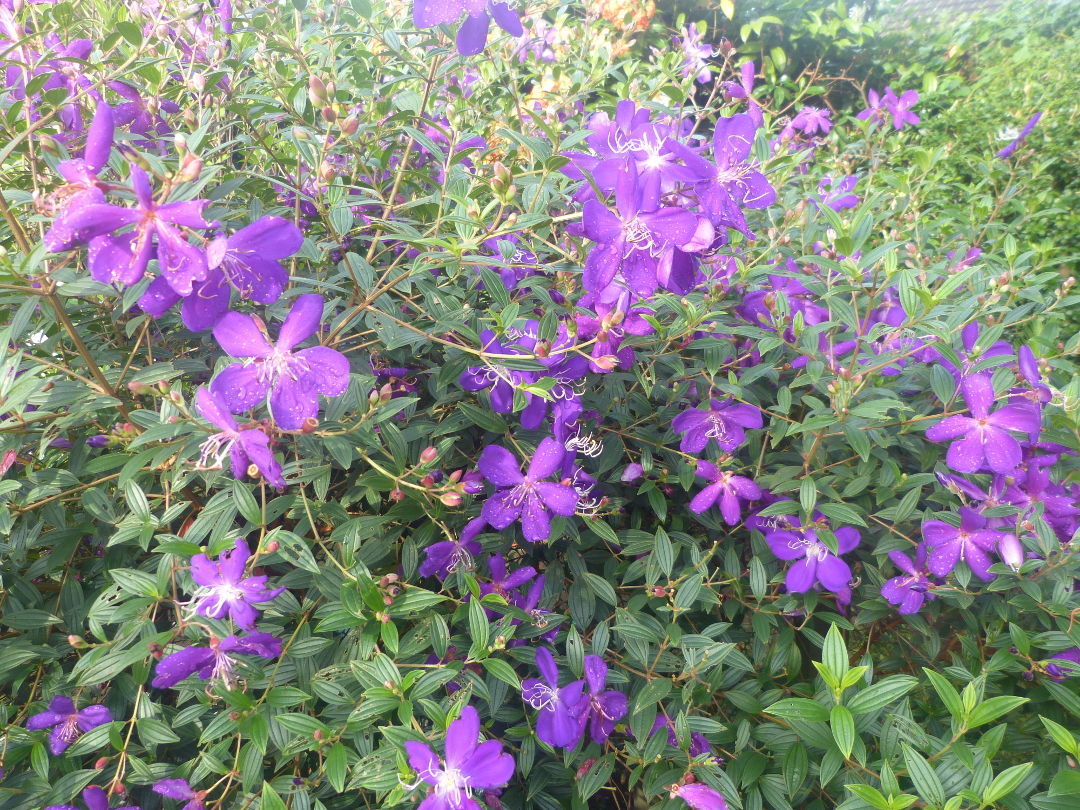
Today we’re visiting Kannan Pasamanickam’s garden.
We live in a bungalow house in Petaling Jay, West Malaysia, with 7200 square feet of surrounding land—enough for all my gardening aspirations. The garden enabled me to teach my children to bicycle and play football and badminton when they were young.
From 1995, after consulting books and surfing the internet, I drew plans to grow a garden with many tropical plant and trees. I wanted different varieties of flowers with myriads of shapes and colors. Many trips were made to a leprosarium in a nearby town called Sungei Buloh. Many of the residents here had been cured of the disease and made a living by running nurseries. I learned by trial and error that certain plants preferred certain parts of the garden where they would thrive and flower well; this was due to the amount of sunlight and shade they required through the day. The best example was the Alpinia purpurata (red ginger, Zones 9–11). The plants would slowly die wherever I planted them until I found a spot in a northern location of our garden that received a few hours of afternoon sun and then shade. There the plants thrived, reaching heights of 5 feet and producing large blooms. Jasmine trees that I have planted in front of the house hardly produced flowers, but birds carried the seeds to the back of the house, resulting in three big trees that would be covered with hundreds of flowers, especially after a day of sunshine following a thunderstorm. The whole house would be filled with the intoxicating smell of jasmine.
One of the joys of gardening is in going to a nursery and finding the elusive plant that you have been searching for. A greater joy awaits you when you are able to propagate the plant and, after toiling with manure and fighting off bugs and snails, it rewards you with a beautiful bloom. I chanced on a Curcuma ginger plant in a nursery near my hospital and brought home three plants. It produced beautiful blooms, and then suddenly snails attacked and all the plants died. With a heavy heart I carefully dug up the bulbs and replanted them. Nothing happened for four months; I was ready to give up and plant something else, but my wife advised me to be patient. Then suddenly two weeks before Chinese New Year 2019, shoots appeared and grew quickly, producing a bud that bloomed on the first day of Chinese New Year—what ecstasy!

Alpinia purpurata (red ginger, Zones 9–11) thriving and blooming in a mostly shaded spot.

Alpinia purpurata flowers close up.

Curcuma ginger plant blooming for Chinese New Year after recovering from snail damage.

Spiral ginger (Costus speciosa)

Heliconia ‘Orange Panama’

Scarlet banana (Musa caccinea)

Lobster claw plant (Heliconia rostrata)

Wax plant (Hoya carnosa) blooming on a chain-link fence.

Spiked spiralflag ginger (Costus spicata)

Tibochina urvilleana (princess flower, Zones 8–11)
Have a garden you’d like to share?
Have photos to share? We’d love to see your garden, a particular collection of plants you love, or a wonderful garden you had the chance to visit!
To submit, send 5-10 photos to [email protected] along with some information about the plants in the pictures and where you took the photos. We’d love to hear where you are located, how long you’ve been gardening, successes you are proud of, failures you learned from, hopes for the future, favorite plants, or funny stories from your garden.
If you want to send photos in separate emails to the GPOD email box that is just fine.
Have a mobile phone? Tag your photos on Facebook, Instagram or Twitter with #FineGardening!
You don’t have to be a professional garden photographer – check out our garden photography tips!
Do you receive the GPOD by email yet? Sign up here.

















Comments
It goes without saying (ha, and yet I am ), that you live in a tropical paradise, Kannan, and the flowers that you successfully grow are so gloriously colorful and have such interesting shapes. It sounds like you put a lot of thought into where you plant your selections and try to give them their best chance to reach their full beauty. Thank you for sharing your pictures.
Thank you Michaele. Great pleasure to share. We lived for 1 year in Seattle, Washington State during my training in 1989 and loved the flowers that would not grow in our tropical climate in Malaysia ; on the other hand the climate at home allows the propagation of different variety of plants that we enjoy.
Kannan
Wow! It is always great to see gardens from other lands. Beautiful blooms!
Thank you Treasuremom
Kannan
I love the story about the Jasmine seeds dropped by birds in the perfect location to thrive! Also interesting how people at the leprosarium that were cured and made a living selling plants and running nurseries. And I know just what you are talking about when you search by trial and error for the perfect location that a plant will survive and thrive! It's been fun seeing the tropical plants of your West Malaysa garden, thanks for sharing these posts.
Thank you SimpleSue.
Yes I have been grateful to my garden bird visitors for heling me to propagate my plants.
I first visited the leprosarium as a medical student and used to buy roses for my girlfriend ( very cheap compared to prices in the city, and great for a student's budget ) ; once I started working the leprosarium fulfilled the needs of my gardening interests as well as that of fellow gardeners from the surrounding suburbs - very crowed on weekends.
Kannan
What a great garden and story of how you created and still are creating it! Especially love that the healed lepers now can make a living selling plants - wonderful. The curcuma ginger is gorgeous!
Thank you BTucker.
I have not been to the leprosarium for a long time - I first went about 40 years ago and my last visit was about 10 years ago (no more space to add more plants and many new nurseries have sprung up near my home in recent years for my gardening needs). The area where the leprosarium was situated has physically changed a lot with the march of time and progress of development. Many of the patients have retired ; in some families the children have expanded and taken over the running of the nurseries. Other families have moved on to other occupations. However the Sungei Buloh area still attracts alot of garden enthusiasts especially on the weekends
Kannan
Wow! What an amazing garden! Kannan, thank you for sharing all this beauty! It really is an inspiration to hear how you have allowed nature - and the plants - to dictate where things will thrive. I have struggled with this, myself and I found that when I settled down and paid attention to what the plants were telling me I had much greater success.
One thing re slugs and snails - I had a slug infestation a few years ago that threatened my hostas. We'd just finished some electrical work so I stripped the leftover copper wiring and laid two concentric copper rings around each plant (at the base it's not so wide so I didn't need that much wire). Within a week all the slugs were gone (I don't have much problem with snails but I'm thinking it would be similar).
Thanks again for sharing all this beauty!
Thank you Musettel. Great advise - I am going to try your copper wire treatment - will certainly be more environment friendly than the anti snail pesticides I am currently using.
And yes i agree - we must listen to nature and not dictate our human terms. Gardening has also taught me life philosophies.
Kannan
Log in or create an account to post a comment.
Sign up Log in